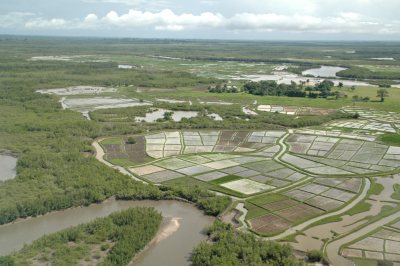The flora of Guinea-Bissau
The flora found in Guinea-Bissau is influenced by the geographical situation of the country, the climate, soils and its slightly accentuated relief. Like all the natural elements of the country’s environment, plants are extremely important to Guinean populations. They are important both for food, housing construction, artifact and furniture manufacturing, as well as for movements of cultural demonstrations and for traditional medicine. Around 128 different plants from Guinea-Bissau, of the nearly 900 that have been identified by the scientific literature, are used as “traditional medicine”. The man consumes about 70 of these and uses almost 90 of them to produce handicrafts and to manage the pasture.
You can see several types of landscapes that are very different from each other. The mangroves, found in the expanses of the rivers, can reach 5 meters high (Avicennia or low mangal) or even 10 meters high (Rhizophora or high mangroves). Only a few sodium tolerant plants are able to survive the conditions of the tannes zones. The soil is practically sterile in these slandy-sandy areas, saturated with salt, which precede the mangrove.
The flooded rice paddies, called bolanhas, are predominant in southern Guinea-Bissau, precisely because this is the area of highest humidity in the country. The sub-humid forest is found in this locality, mainly on some islands of the Bijagós Archipelago, and in the regions of Quinara and Tombali. In this type of forest, one can find above all “Dust of misery” (Anisophylla lamina), “Polon” (Ceiba pentandra) and “Pó de bitcho amarelo” (Chlorophora regia) – large trees, measuring between 30 and 40 meters high.
Among the sub-humid forests and the dry and semi-dry forests, there are transition forests, in which the Ceiba pentandra tree predominates, known as “poilões” in Guinea-Bissau. The transition forests are mainly located in the Coast and in the Gabú Region. In dry and semi-dry forests, located in the North-Central and Central-south areas of the country, the species “Conta pó” (African Afzelia), “Palmeira de Óleo” (Elaeis guineensis), “Manconde” (Erytrhopheleum guineensis), “Bissilon” (Khaya senegalensis), “Pó de Sangue” (Pterocarpus erinaceus) and “Pó de Póvão africana” (Prosopis Africana) stand out.
In the interior of Guinea-Bissau is the wet herbaceous savannah area, characterized by virtually no trees, no shrubs. However, in the region, some palm trees can be found, in particular the palm tree of the species Borassus aethiopum, called Cibe in the country.
Currently, biodiversity and the development of ecosystems are threatened by human intervention. Several actions are responsible for the alteration and depreciation of the flora in the country: demolition of trees in forests and the practice of seasonal fires to make use of the soil in agriculture, the exaggerated extraction of wood that is considered noble, the practice of monoculture, especially rice, cashew and peanuts. All this, among other factors such as climate change and demographic pressure can alter the country’s natural balance and irreversibly harm its plants and vegetation.
Related articles
History of Guinea-Bissau
Before being colonized by the Europeans, almost the entire territory of Guinea-Bissau was part of the Kingdom of Gabu, tributary of the Empire of Mali, of the Mandingas, which had flourished from 1235. Rich and sumptuous state, it extended between the Senegal River Region and Upper Niger.


